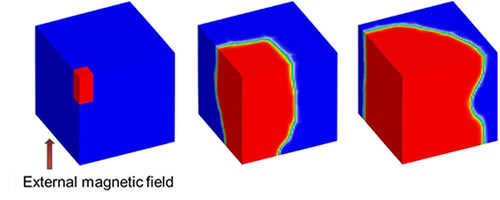Today Fujitsu Limited announced it has developed the world’s largest magnetic-reversal simulator. Developed in joint research with the National Institute for Materials Science (NIMS), the simulator runs on the famous K computer using a mesh covering more than 300 million micro-regions. Based on the large-scale magnetic-reversal simulation technology first developed in 2013, this new development offers a faster calculation algorithm and more efficient massive parallel processing.
In addition, by utilizing this technology, Fujitsu conducted large-scale simulations to clarify the correlation between the fine structure of neodymium magnet, a type of permanent magnet, and magnetic strength, by examining the process of magnetic reversal in neodymium magnets. The results successfully demonstrated a way to develop high-strength neodymium magnets with more than twice the coercivity of previous magnets, without dysprosium. In conventional neodymium magnets, dysprosium alloying is indispensable for enhancing magnetic coercivity. These simulation techniques offer a clear design rule for high-performance neodymium magnets that do not rely on dysprosium.
Fujitsu and NIMS will be making a joint presentation on these results at the 13th Joint MMM-Intermag Conference, running January 11-15, 2016, in San Diego, California.
Background
In recent years, the increasing momentum for energy conservation has brought attention to improving the efficiency of motors and generators that use magnetic materials. Currently, neodymium and dysprosium elements are indispensable to manufacture top performance iron-based permanent magnets for these applications. However, as a natural resource, dysprosium is only about 10% as common as that of neodymium, which may make for issues with regard to stable supply. This is why there is a high need to develop strong dysprosium-free neodymium magnets.
About the Simulation
In 2013, Fujitsu and NIMS jointly developed the large-scale magnetic-reversal simulation technology that uses the finite-element method and micromagnetics. Running these simulations on the K computer helped to clarify the mechanism of coercivity in neodymium magnets. Previously, dysprosium was used in neodymium magnets in order to increase the coercivity, the resistive force against a demagnetization field during operation of motors and generators. To develop a neodymium magnet that does not use dysprosium, simulations of the demagnetization processes under the presence of a reverse magnetic field is necessary. This, in turn, requires a massively complex simulation to represent the process of magnetization reversal, using a model of a neodymium magnet with a mesh divided into 1-nanometer sections. Toward that end, the research team refined the computational algorithm used in the simulation and increased parallelization by a factor of roughly ten to more than 10,000, allowing for efficient massive parallel computations. This enabled the researchers to develop a magnetic-reversal simulator using a mesh with more than 300 million nodes, or roughly 60 times more than before.
For this simulator, the research team created a polycrystalline model in which 27 neodymium-magnet crystals were magnetically bonded, and simulated the process of magnetic reversal while varying the strength of the magnetic couplings between the crystals. This led to the discovery that changes in the strength of the magnetic coupling between crystals in the lateral direction greatly affect the process of magnetic reversal, while the magnetic decoupling in the perpendicular direction is not so effective. The simulation showed for the first time that the magnetic decoupling of the crystals in the lateral directions double the coercivity of neodymium magnets, which could obviate the need for dysprosium.
Previous experiments decoupled the magnetic grains in the perpendicular direction, which did not result in sufficiently high coercivity. This simulation clearly shows that even when crystals are bonded vertically, decoupling the grains in the horizontal direction results in a dramatic increase in coercivity. This work has clearly shown the direction toward the development of strong neodymium magnets without dysprosium.
Future Plans
The Ministry of Education, Culture, Sports, Science and Technology’s “Elements Strategy Initiative Project”, carried out at NIMS in the Elements Strategy Initiative Center for Magnetic Materials, aims at developing neodymium magnets that require no dysprosium by 2017. To achieve this target, Fujitsu and NIMS will work together, using the K computer to conduct massive, ongoing simulations that pave the way toward developing strong neodymium magnets that do not need dysprosium, contributing to Japanese industry as a whole.





